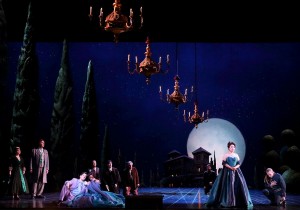LA Opera’s revival of The Marriage of Figaro completes this season’s so-called Figaro trilogy and reveals Mozart at the height of his genius. To the glorious music, add a heap of silly antics, lavish costumes and eye-popping sets and you have a recipe for pure pleasure, and that is just what LA Opera delivers.
Mozart’s The Marriage of Figaro, or The Crazy Day derives from the second of a trilogy of plays by Pierre Beaumarchais that were wildly popular in pre-Revolutionary France for mocking the foibles of the aristocracy. The first play in the set, The Barber of Seville, is best known today from the popular Rossini opera of 1816 (which was performed at LA Opera in late February). The last play, The Guilty Mother, is much less known and was performed by LA Opera in early February under the guise of John Corigliano’s 1991 The Ghosts of Versailles.
The Crazy Day in question takes place some years after Count Almaviva has married his heartthrob Rosina, whom he pursued so ardently in The Barber of Seville. But now his ardor seems to have cooled and his wandering eye has fixed on Susanna, his wife’s maid. It is Susanna’s wedding day, and the count is determined to invoke his droit de seigneur by bedding her before her nuptials to Figaro. Inevitable and hilarious complications ensue until the end when all is set right.
Figaro is an opera buffa, an 18th-century development that highlights comic situations, usually involving servants speaking common dialects. In writing it, Mozart chose as his writing partner Lorenzo da Ponte, court librettist to Emperor Joseph II, who was a character in his own right, having been a priest and brothel operator in Italy until he was run out of town. Da Ponte translated the words of the play to Italian, toned down the political rhetoric and amped up the comedy. With Mozart’s supreme musical vision, the pair fashioned a masterwork that many agree is the most perfect opera ever written with nary a false note.
With this production, and the direction of Ian Judge, the opera is buffed up to a brilliant gleam. It opens with Figaro painting the black walls of a stately salon red. It is an apt metaphor for what is about to unfold, especially the spectacle of unloosed passions running rampant. The other sets are just as luscious with a bedroom done in gold leaf, an office in bright green and black, and a patio with a vivid blue background. The visual clues that place us in time are mixed up, with the men wearing the typical 18th-century breeches, blouses and buckles, while the women wear outfits reminiscent of the New Look that Christian Dior introduced in 1947. Other mid-20th-century details include Hollywood Regency style furnishings, antique telephones and a vintage copy of Vogue on a nightstand. The net effect is something a bit removed in time, but not very far.
The cast is very good, with particular kudos going to Roberto Tagliavini as Figaro who displayed a strong and exuberant basso/baritone tone. Interestingly, the two main female roles, Countess Almaviva (Chinese soprano Guanqun Yu) and Susanna (South African soprano Pretty Yende), were both first-place winners of the prestigious Belvedere opera competition in 2008 and 2009, respectively. While both revealed technical adeptness with tender and mellifluous voices, there was a remarkable aural equivalence between the two such that if I closed my eyes, I had trouble telling one from the other. Mezzo-soprano Renee Rapier as the teenage page Cherubino sang well and had a spunky presence, but was unable to disguise her femininity in a role seemingly tailor-made for a castrato to sing. Interestingly, Mozart did originally cast a female to play this gender-bending role and not a castrato — although they were certainly available at the time.
In the opera’s 1786 debut, Mozart sat at his fortepiano while simultaneously conducting the orchestra. For this production, James Conlon stands alone, but as always, coaxes a reliably true and impeccable performance from his musicians. From the explosive overture at the beginning to the stupendous finale with its fortissimo choral passage accompanied by real fireworks, this is a musical tour de force you could happily listen to again and again.
If you have some non-opera-going friends, round them up and take them to this production. They will thank you for a lovely, entertaining evening and perhaps will also be tempted to dip their toe in again for some of the more challenging fare to come.
—David Maurer, Culture Spot LA
The Marriage of Figaro continues through April 12 at the Dorothy Chandler Pavilion, 135 N. Grand Ave., LA 90012. For tickets or more information, call (213) 972-8001, or visit https://www.laopera.org.






